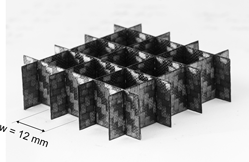Article contents
C/C–SiC sandwich structures manufactured via liquid silicon infiltration
Published online by Cambridge University Press: 07 July 2017
Abstract

In a new design approach, C/C–SiC sandwich structures have been realized via liquid silicon infiltration and in situ joining methods. In the first process step, the carbon fiber reinforced polymer preforms for the planar skin plates as well as for the core structures were manufactured via warm pressing and autoclave technique, using C fiber fabrics preimpregnated with phenolic resin. Thereby, two types of C/C–SiC core structures were used: foldcore and grid core. In the second process step, the sandwich components were pyrolyzed separately, leading to porous C/C preforms and subsequently joined to a C/C sandwich structure, using an adhesive. In the last process step, the C/C structure was infiltrated with molten Si, and the SiC matrix was built up by a chemical reaction of Si and C, leading to a permanently joined C/C–SiC sandwich structure. For mechanical characterization, sandwich specimens were manufactured and tested in 4 point bending.
- Type
- Invited Articles
- Information
- Journal of Materials Research , Volume 32 , Issue 17: Focus Issue: Achieving Superior Ceramics and Coating Properties through Innovative Processing , 14 September 2017 , pp. 3383 - 3393
- Copyright
- Copyright © Materials Research Society 2017
Footnotes
Contributing Editor: Nahum Travitzky
References
REFERENCES
- 6
- Cited by





